![]()
![]()
![]()
Use LEFT and RIGHT arrow keys to navigate between flashcards;
Use UP and DOWN arrow keys to flip the card;
H to show hint;
A reads text to speech;
48 Cards in this Set
- Front
- Back
|
What is the immune system?
|
A bunch of cells throughout the body whose purpose is to recognize invading microorganisms, attack them, and eliminate them.
|
|
|
The immune system responds to ___ which by definition are
|
antigens
any antigen is a molecule that is non-self. The immune system attacks the non-self antigen: the foreign. |
|
|
When the immune system attacks infectious agents it's an example of ...?
if it's a tumor...? Innocuous substances? grafted organs? self organ? These are all examples of a ___ immune response |
protective immunity
tumor immunity allergy rejection autoimmunity normal- it's normal operations even if outcome is detrimental |
|
|
The immune system responds to microbes in a manner ___ to the type of pathogen. The manner in which it responds is different for bacteria or fungi, so that choice is ___.
|
tailored
critical-- if you don't respond right, the immune system generates the wrong kind of immune response and it doesn't work --> super bad infection |
|
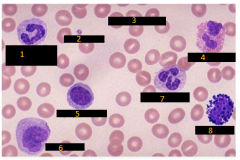
Can you name them?
|

|
|

All of these EXCEPT ___ are in the ___ immune response
|
lymphocyte is not in the innate immune response
|
|
|
Innate immune response is equivalent to the ___ inflammation response we learned about
|
acute
|
|
|
Lymphocytes then are part of the ___ immune response
|
adaptive
|
|
|
We identify two types of lymphocytes:
|
the T cells and B cells
|
|
|
The immune system is considered ___ meaning cells are everywhere though they are ___ in certain tissues like:
|
systemic
concentrated or accumulated bone marrow and thymus |
|
|
T/F: Most immune cells are in the primary lymphoid tissue like bone marrow and thymus.
|
No.
They are concentrated in these organs (more concentrated than other places), but in absolute number, most of the cells are out in circulation doing their jobs as immune cells |
|
|
What organs/tissues are 1o lymphoid (primary lymphoid)?
Which organs/tissues are 2o lymphoid (secondary)? |
bone marrow and thymus
adenoid/tonsils, lymph nodes, appendix, spleen, parts of small and large intestine |
|
|
What is in/happens in secondary lymphoid tissues?
|
Contain only mature cells (no precursors like in primary).
This is where the immune response is initiated. |
|
|
What are lymphatics and blood circulation systems considered? Why does this matter/what is their role?
|
super highway between the different tissues/organs of primary and secondary lymphoid tissues.
This is important because the cells have to find an infection, go to secondary lymphoid tissues, then go back to infection. |
|
|
Where do you find the hematopoietic stem cell?
It has the potential to become ____ making it a ___ cell. |
bone marrow
every cell in the immune system (and more) pluripotent |
|
|
How do you identify a hematopoietic stem cell in the bone marrow?
|
You use the marker CD34
|
|
|
The CD markers are used to ....? (2)
|
driving the immune response: interacting with other cells and extracellular matrix
|
|
|
Hematopoietic stem cells can directly become 3 cell types. Name them.
|

Three progenitor cells:
common lymphoid common myeloid common erythroid |
|
|
What does common lymphoid cell give rise to?
How would you describe then the response type that arises from the hematopoietic stem cell -> common lymphoid progenitor? |
lymphocytes, so B cell and T cell
This is the stem cell giving rise to the adaptive immune response cells. |
|
|
What does common myeloid cell give rise to?
How would you describe then the response type that arises from the hematopoietic stem cell -> common myeloid progenitor? |
Basically granulocytes (neutrophils, eosinophil, basophil) and monocytes (dendritic cell and macrophages)
This is the stem cell giving rise to the innate immune response cells. |
|
|
The erythroid cells aren't actually part of the immune system. It's made up of
|
RBC and platelets
|
|
|
What triggers a B cell to go into a plasma cell?
This same trigger makes T cells turn into..? |
antigen
effector T cell |
|
|
Run it back- draw out the differentiation of immune cells from the stem cell.
Bonus points if you include info on type of response and/or location. |
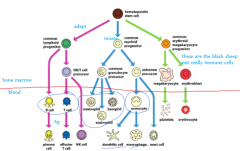
**Note: The NK/T cell precursor --> T cell does NOT take place in bone marrow but in the THYMUS**
|
|
|
What do plasma cells do?
|
Pump out the antibodies.
|
|
|
The process of hematopoietic stem cell going into the different cells happens at what age?
|
All ages- your entire life (though it declines in old age)
|
|
|
The innate pathway is pumping out how many neutrophil cells a day?
The adaptive's T cell? |
10^10 or 10^11 number of cells made.
10^6 A lot. |
|
|
What are some of the ways innate and adaptive immunity differ?
include info about timeline, receptors, evolution (~6 things) |
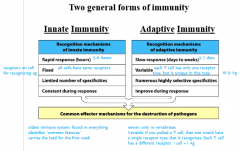
|
|
|
T/F: When comparing innate and adaptive immunity mechanisms, the differences lie much more with the recognition mechanisms as opposed to the destruction effector mechanisms which is basically the same for both pathways.
|
True
The map shows both going to the same "common effector mechanisms for the destruction of pathogens" |
|
|
The innate immunte system is made up of ___ proteins and ___ (kind of a stupid question). It's mediating ___ inflammation.
|
soluble/serum proteins and cells
acute |
|
|
In healthy skin under all ___ layers that are ___ cells aka ____. There are also ___ proteins. These are present all the time even when there is no infection.
|
epithelial
effector cells or tissue resident macrophages complement |
|
|
As soon as something breaches the epithelial layer, the macrophages are in high enough concentration that one comes in contact to trigger the complement system. That includes macrophages phagocytosing the invader and releasing cytokines like ___ which do what?
The microorganisms are also leaving behind ___ which will go out and trigger the ___ system |
IL-6, TNF, IL-1
preps vasculature (vasodilation and increased permeability) to get in neutrophils Ag for adaptive system |
|
|
During the process of phagocytosing invaders after epithelial breach, it's really a ___ of getting rid of the invader faster than it can multiple. The injected tissues become __________ (5 descriptors).
|
race
inflamed, causing redness, heat, swelling, pain |
|
|
The adaptive immunity system can be split into two categories.
|
Humoral and cellular
|
|
|
Humoral immunity uses what type of effector cell? What does it use for Ag elimination?
What types of pathogens does this kill? |
B cell
antibodies- circulates and finds the pathogen Extracellular pathogens- live in body fluids and once they're phagocytized, they're effectively killed. It makes sense that antibodies which float around kill pathogens that live extracellularly. |
|
|
The adaptive immunity's cellular immunity system uses two cell types: name them.
How does this system undergo Ag elimination? What pathogen type is killed with this system? |
T cell's: CD4 T and CD8 T
Direct cell-cell contact (the T cell has to actually be there- not sending out floater messages like antibodies) Intracellular ones: when they get phagocytized or for whatever reason get inside one of your cells (phagocytic ones or some parenchymal cell) they don't care- they live happily |
|
|
What is the implication and potential problem of the humoral and cellular immunity systems targeting pathogens in different ways?
|
We can get rid of both kinds of pathogens, but the body has to know which system to use-- if you used a humoral immunity attack on an intracellular pathogen, it's not going to be very effective.
|
|
|
When a ___ protein antigen is in it's 3D structure, it's recognized by ___. Why is that?
|
native
antibodies It makes sense because antibodies are looking for extracellular pathogens which are going to be intact. |
|
|
What do T lymphocytes recognize? Where does it find these?
|
They just look for a peptide stretch from the antigen that is formed during the degradation of the antigen- never the native conformational form.
The things T cells are recognizing are actually presented on the surface of other cells- the "antigen presenting cell". This is the cell-cell contact that is required. |
|
|
The concept clonal selection means what?
|
Lymphocyte repertoire is extrememly diverse in its antigen receptors-- 10^9 T and B cells looking (all the time trying to find something to fight even absent of infection). A single lymphocyte finds an invader Ag that matches it- that lymphocyte now undergoes proliferation (clones) and differentiation to effector cells.
Basically: pathogen selects lymphocyte which clones. |
|
|
The adaptive immune response to antigen is ___ at the site of antigen entry
|
NOT initiated
the antigen has to migrate to a lymph node or other secondary lymphoid tissue to initiate this immune response |
|
|
What is a naive lymphocyte? What does it do?
|
A cell that has the right receptor for the Ag but has not come into contact with that Ag yet. It's circulating around. When it goes through the lymph node (or whatever) where the Ag is, it finds it, but now has to go back to the site of infection which is kind of a journey.
|
|
|
How does the lymphocyte get to the site of infection after finding its Ag?
What is critical in this process? |
It goes through the lymphatic drainage to get back into the blood, go back into circulation, and make their way to site of infection to eliminate it.
The circulation is critical for an effective adaptive immune response. |
|
|
There are three types of naive lymphocytes: name them.
Each one becomes a different type of effector cell: name them. What does each of those effector cell types secrete? |
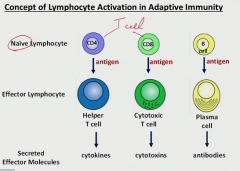
naive CD4 -> helper T cell -> cytokines (hormonal like proteins that affect surround cells)
naive CD8 -> cytotoxic T cell (aka killer T cell) -> cytotoxins to kill naive B cell -> plasma cell -> antibodies (circulate and contribute to killing of target) |
|
|
Describe the kinetics of the adaptive responses in a relative fashion of the pathogen specific response during a primary response and secondary response.
|

First 5-7 days is a lag phase.
The effector function accumulates and increases in the body. When the antigen is gone, it plateaus and then decays, but doesn't go down as far as before-- there is a residual response- "immunological memory" For secondary immune response: lag phase much shorter and response is much more vigorous. |
|
|
Describe the kinetics of the innate responses in a relative fashion of the pathogen specific response during a primary response and secondary response.
|
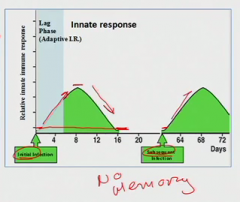
Lag is very very short. It peaks, and when organism is gone, it immediately decays. There is no memory.
The next time that organism appears, it is the exact same pattern of reaction. |
|

it's beautiful, isn't it?
|
Yes.
|
|
|
___ immune reactions can cause injury to normal tissue via two types of reactions-- explain each one
|
Excessive/abnormal reactions
Hypersensitivity: exaggerated immune response to foreign antigen which causes indirect injury to normal tissue (pollen or food) autoimmune reactions: abnormal immune response to self molecules which causes direct injury to normal tissues |
|
|
In a normal situation, autoimmune reactions don't happen because of ___
|
tolerance
(it's easy to remember this term because the whole "attack anything foreign!!" sounds like racism, and common anti-racism phrases are things like "increasing tolerance in the workplace") |

